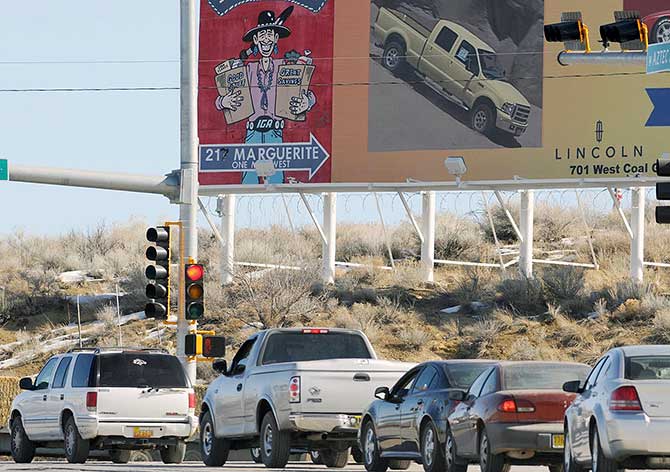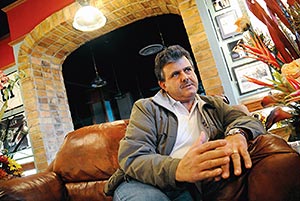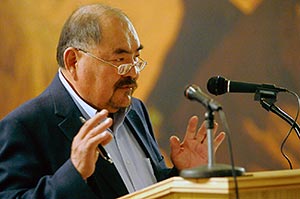Page school segregation persists, activists say

(Times photo - Donovan Quintero)
A caricature of a Navajo man along Highway 602 in Gallup entices customers to shop at the Shop-n-Save grocery store.
By Cindy Yurth
Tséyi' Bureau
PAGE, Ariz., Jan. 22, 2009

(Times photos - Donovan Quintero)
Sammy Chioda says a positive aspect about Gallup is that it is a melting pot of different nationalities.

Collier Grayhat, co-founder of Diné Communities for Equality in Education Inc., speaks at the Navajo Nation Human Rights Commission meeting Monday in Page, Ariz.
I t was Martin Luther King Day Monday but you couldn't tell in this hibernating tourist town on the shore of Lake Powell.
No banners flapped in the gentle breeze on this gorgeous 50-degree day, no parades clogged the streets, no one recited the "I Have a Dream" speech.
One of the town's few black residents, a likeable homeless man, was found murdered several months ago and the case is still unsolved.
In a conference room at the Quality Inn, however, the Navajo Nation Human Rights Commission quietly commemorated the great civil rights leader's legacy by taking stock of how much is left to be done to achieve the equality he championed.
The five-member commission had scheduled public forums on race relations in both Page and LeChee, Page's sister community across the Navajo Nation boundary.
The commission had hoped holding the forums in mostly Navajo LeChee and mostly white Page would encourage people of all races to attend, but the only non-Navajos to show up at either forum were two newspaper reporters.
Most of the complaints heard by the commission involved Navajos being passed over for jobs or promotions while their Anglo colleagues seemed to rise easily through the ranks.
The commission heard similar stories in the three other Arizona towns where it held hearings: Holbrook and Winslow and Flagstaff.
The commissioners advised the complainants that such allegations are hard to prove, and urged them to collect any written evidence or testimony from co-workers that would support their charges.
If enough evidence of job discrimination can be collected, said commission Chairman Duane "Chili" Yazzie, the commission will confront the offending employers.
Segregation lives on
Two Page men, however, had an even more disturbing report: After six years of pestering the school board and a lawsuit in federal court - and 54 years after the U.S. Supreme Court shot down the "separate but equal" doctrine in Brown v. Board of Education - Page continues to have segregated elementary schools.
Collier Greyhat and Wally Brown, founders of Diné Communities for Equality in Education Inc., said they tried fruitlessly for years to reason with the school board and superintendent.
Then, in 2006, they filed a class action lawsuit alleging the Page school district had gerrymandered bus routes and student assignments to herd Native students into Desert View Elementary while most white students attended the newer and better-equipped Lake View Elementary.
The schools are a stone's throw apart, and yet statistics for the 2004-05 school year showed Desert View was 92 percent Native, compared with just over half of Lake View's students.
According to Greyhat, the townsfolk commonly refer to Desert View as "the Indian school."
Meanwhile, the district was racking up federal subsidies by focusing on its large Native American population but that money didn't necessarily find its way to the Native students, the men alleged.
Instead it was spent on a swimming pool, athletic programs and after-school activities that most of the Navajo students can't attend because many of them have a two-hour bus ride to their homes as far away as Navajo Mountain and Bodaway-Gap, Ariz.
In 2007, according to Greyhat, the two sides agreed to have the dispute mediated by the U.S. Department of Justice. They came up with a list of action items to desegregate the schools.
Things were looking up, or so Brown and Greyhat thought. But as the months rolled on with no word from the district and no apparent movement on the segregation issue, they became suspicious.
Audit uncovers problems
By the end of 2008, it became obvious Page Superintendent of Schools Greg Conway was fighting his own battles, and they had nothing to do with Navajos.
The Arizona auditor general released a report accusing Conway of embezzling $17,000, covertly creating an $87,000-a-year position for his wife, and handing out tens of thousands of dollars to himself and other high-ranking administrators in unmerited "performance bonuses."
According to Brown and Greyhat, the district is still reeling from the audit findings and wondering if there was any complicity from Conway's deputy, now the acting superintendent, who they say is spending most of his energy these days denying he knew anything about the misappropriations.
While the bilagáanas bicker over spilled dollars, the men charge, the Navajos' concerns have fallen quietly through the cracks.
The school district has missed two of the quarterly reports it agreed to give to Diné Communities, and the plaintiffs fear they may have to reactivate their lawsuit.
Meanwhile, they are still fundraising to pay their lawyers for the last bout in court, and although four Navajo Nation agency councils passed resolutions urging the Navajo Nation Council to support the suit, no money from the council has materialized.
Commissioner Steven Darden applauded the men for their "courage" and urged them to keep fighting.
Yazzie said the incident, along with the rest of the complaints collected during the commission's series of border town meetings, will make their way into two reports that will be presented to the council and the United Nations Indigenous Caucus.
"Hopefully the council will direct us to meet with local governments, individuals and employers to try to find solutions to these continuing problems," he said.
Unique issues
On Tuesday the commission moved on to Bluff and Blanding, Utah, and in the coming months will hold hearings in Farmington and Gallup, and possibly Colorado communities like Cortez and Durango.
"We're still thinking about whether we need to go to the major cities, like Phoenix and Albuquerque," Yazzie said. "The Navajos there have their own concerns too."
While some common themes like employment discrimination keep cropping up, Yazzie said the commission has found so far that each border town has its unique issues.
In Winslow and Holbrook, for example, the commission heard about unsolved murders of Natives and problems resulting from the forced relocation of Navajos living in the former Joint Use Area.
In Flagstaff, the complaints centered around the desecration of Dook'o'ooslííd, "institutionalized racism" at Northern Arizona University, and poor treatment of Diné customers in the local restaurants and shops.
One thing Yazzie wishes would come up but hasn't yet is the vulnerability of Native alcoholics who go to border towns in search of booze, and wind up camping in vacant lots or passed out in the streets.
"These people are often roughed up, robbed or even murdered," Yazzie said. "I'm hoping the commission can take on that issue, but people in that situation aren't used to the system helping them and it's hard to get them to come forward."
Agreed Darden, "We need to find a way to reach our most disenfranchised residents."

